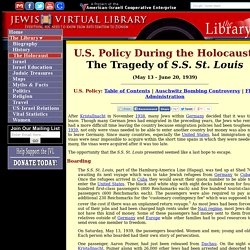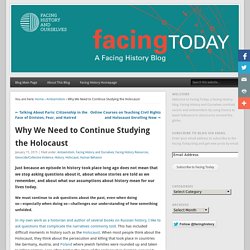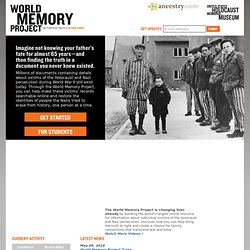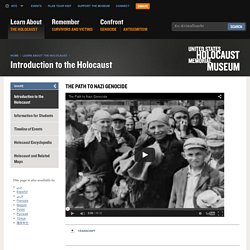

Iess303. History Unfolded: US Newspapers and the Holocaust. The Tragedy of S.S. St. Louis. (May 13 - June 20, 1939) : Table of Contents | Auschwitz Bombing Controversy | FDR Administration After Kristallnacht in November 1938, many Jews within Germany decided that it was time to leave.

Though many German Jews had emigrated in the preceding years, the Jews who remained had a more difficult time leaving the country because emigration policies had been toughened. By 1939, not only were visas needed to be able to enter another country but money was also needed to leave Germany. Since many countries, especially the United States, had immigration quotas, visas were near impossible to acquire within the short time spans in which they were needed. The opportunity that the S.S. Boarding The S.S. Many other passengers had either left family members behind while some were also going to be meeting relatives that had traveled earlier.
There is a somewhat nervous disposition among the passengers. The Path to Nazi Genocide. Pre-war Jewish life. The Doomed Voyage of the St Louis Documentary. How did the Nazis use propaganda? - The Holocaust Explained Website. Goebbels sought to Nazify the whole of German culture, wiping away what Hitler saw as the ‘decadence’ of 1920s Weimar Germany, painting instead a picture of a Germany with traditional values and with Hitler as the beloved Führer.

The promotion of Nazi racial policy was at the very centre of Goebbels’s message. The re-writing of school books and the production of antisemitic books, films and exhibitions supported this policy. In 1929, Hitler chose Josef Goebbels as his Minister of Propaganda. Goebbels developed extremely successful campaigns using simple slogans and images repeated over and again in order to win public support for the party. The Nazis spent huge sums on newspapers, leaflets and poster campaigns. Projections of Life: Jewish Life before World War II.
Why We Need to Continue Studying the Holocaust. Just because an episode in history took place long ago does not mean that we stop asking questions about it, about whose stories are told as we remember, and about what our assumptions about history mean for our lives today.

We must continue to ask questions about the past, even when doing so—especially when doing so—challenges our understanding of how something unfolded. In my own work as a historian and author of several books on Russian history, I like to ask questions that complicate the narratives commonly told. This has included difficult moments in history such as the Holocaust.
When most people think about the Holocaust, they think about the persecution and killing that took place in countries like Germany, Austria, and Poland where Jewish families were rounded up and taken to killing centers. Less often told is the story of the Holocaust in German-occupied Soviet territories—places like Lithuania, Latvia, Estonia, Ukraine, Belorussia, and Russia itself. What makes someone a bystander? – Lesson Plan. Introduction After a video surfaced of fraternity members at Oklahoma University singing a racist chant, many people expressed shock and outrage.

The video, along with the discussion surrounding it on group behavior, provides an opportunity to explore the psychology of why some people remain bystanders instead of choosing to intervene. This lesson will help students understand these behavioral processes and their role in our lives and society. Subjects Psychology, Social Studies Estimated Time 1-2 class periods, plus homework for extension assignments if desired Grade level Materials.
World Memory Project. The World Memory Project is changing lives already by building the world's largest online resource for information about individual victims of the Holocaust and Nazi persecution.

Discover how you can help bring the truth to light and create a chance for family connections that transcend war and time. Watch More Videos » Records made available through the World Memory Project are searchable online for free. Search now » May 09, 2014 World Memory Project Turns Three New goal set for project on its third anniversary. March 05, 2014. Read online: Daniel's Story (Carol Matas) [THIS EBOOK IS NOT AVAILABLE FOR DOWNLOAD IN PDF]
VIDEO: What makes genocide possible - syamamura - Island Pacific Academy Mail. The Path to Nazi Genocide — Media. NARRATOR: Paris, 1900.

More than fifty million people from around the world visited the Universal Exposition—a world’s fair intended to promote greater understanding and tolerance among nations, and to celebrate the new century, new inventions, exciting progress. The 20th century began much like our own—with hope that education, science and technology could create a better, more peaceful world. What followed soon after were two devastating wars. TEXT ON SCREEN: The Path to Nazi Genocide NARRATOR: The first “world war,” from 1914 to 1918, was fought throughout Europe and beyond.
Sir Nicholas Winton, Nicky's Children, the Czech Kindertransport. World War I - Battles, Facts, Videos & Pictures - History.com. Treaty of Versailles, 1919. IMPACT OF WORLD WAR I World War I was one of the most destructive wars in modern history.

Nearly ten million soldiers died as a result of hostilities. Archaeologists in Poland Make Horrendous Discovery Underneath the Ground That the Nazis Never Wanted Found. Archaeologists in eastern Poland claim they have discovered new evidence related to the Nazi regime’s evil and murderous history.

Hidden underneath the ground at a former Nazi concentration camp on the outskirts of the village of Sobibor, archaeologists reputedly found gas chambers that were intentionally hidden by Nazis after an uprising in 1943. Officials estimate roughly 250,000 Jews were killed in the gas chambers. Following an uprising at the camp on Oct. 14, 1943, German forces reportedly demolished the gas chambers.